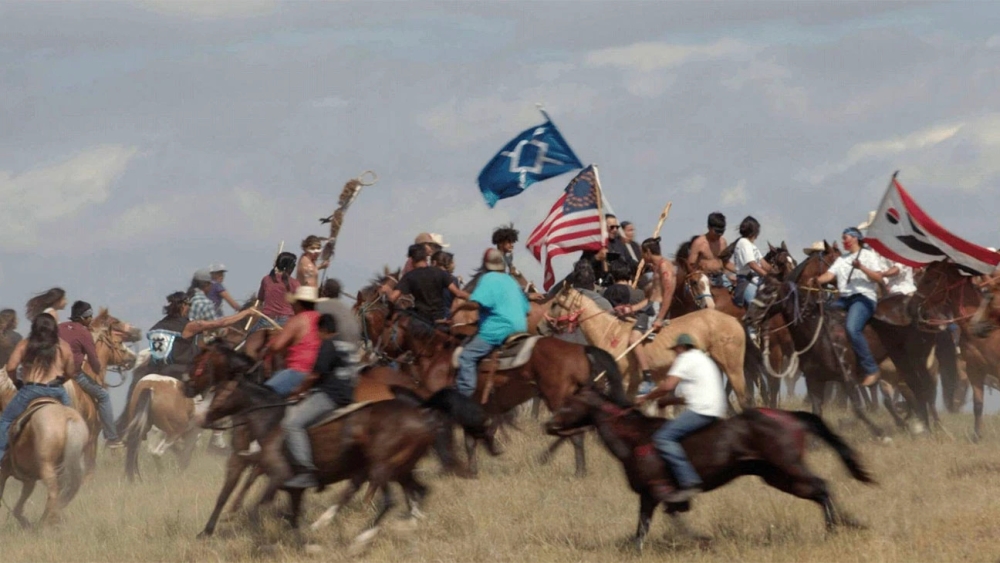
Audiences who’ve attended film festivals or cultural events in the past few years have no doubt heard their share of land acknowledgements, in which the hosts make a point of recognizing the Indigenous tribes who served as the traditional custodians of the space on which they’ve gathered. Though intended to convey respect and awareness, these messages appear to have a kind of triggering effect on some people, who react as if witnessing the first step on a slippery slope to the more controversial idea of reparations.
In “Lakota Nation vs. United States,” land acknowledgements are the main attraction, and reparations may well be the end goal. Co-directed by Jesse Short Bull and Laura Tomaselli, this essential and largely unprecedented Native-issues essay film takes a head-on approach, citing “white fragility” and America’s general unwillingness to confront its treatment of Indigenous peoples as obstacles to resolving decades of unfair treatment. While the subject has been well-covered by the news media, this lucid and ultimately uplifting documentary lets the Lakota speak for themselves, reflecting a much different sensibility. The resulting report feels nothing short of definitive as the duo condenses a wide range of philosophical, spiritual and historical concerns into a thoughtful (and artful) two-hour package.
Striking an unexpectedly poetic tone, the helmers start by inviting Layli Long Soldier, an eloquent Ogalala Lakota writer and activist, to supply a dolorous but hopeful voiceover to the project. They also dedicate approximately a quarter of the running time to achingly beautiful footage of the skies, streams and terrain in question — stunning widescreen panoramas that evoke the unspoiled beauty of land which Americans perceive in terms of property to be owned and exploited, as opposed to “a living entity [that] doesn’t belong to any one person, or even any one nation,” in the words of Craig Howe.
Central among the film’s concerns are promises made (and later broken) by the United States in the peace treaty of Fort Laramie, which established the Great Sioux Reservation in 1868. It read, “the United States now solemnly agrees that no persons, except those herein designated and authorized so to do … shall ever be permitted to pass over, settle upon, or reside in the territory described in this article.” But the government couldn’t keep what a voice heard here calls “the light-eyed people” from entering the territory. Six years later, Gen. George Custer led an expedition, gold was discovered, and efforts began to renege on the agreement, formalized by the Dawes Act of 1887.
The steps by which the United States took back 90 million acres and reallocated it to settlers are too complicated for the movie to untangle, but the overall picture couldn’t be more clear, compounded by a litany of other injustices. The doc explains how guns were confiscated and buffalo killed to force Natives into a European-style farming system, how Indigenous religions were outlawed and children sent away to be Christianized in cruel boarding schools. It also deconstructs how mainstream American media otherized the Natives, making “invasion look like self-defense.” A few well-chosen film clips go a long way to make the point that Hollywood has been complicit in misrepresenting Indigenous interests as recently as Spielberg’s 2012 “Lincoln” biopic, which omits the celebrated president’s decision to execute the “Dakota 38” the same week he signed the Emancipation Proclamation.
Lest the material overwhelm, the filmmakers package their dense talking points into digestible segments, relying on all that arresting nature footage to break up the more depressing historical material. Working magic with archival materials, co-director Tomaselli (doubling as editor) crafts complex but coherent montages of treaties, maps, news reports and egregious vintage educational material, counting on audiences to bring a critical eye as she fills in gaps from the average American’s history curriculum.
For more than a century on screen, the cowboys have beaten the Indians, and yet, in the long arc of history, the balance could well swing the other way. Solutions don’t come easy when attempting to rectify decades of dehumanization, subjugation and erasure, but the Native tribes have not given up their fight. The doc gives voice to activist members of the Land Back movement, while providing valuable context to their struggle, as seen in demonstrations at Standing Rock and peaceful protests outside President Trump’s 2020 Mt. Rushmore rally. In targeting this particular monument, carved into the Lakota’s ancestral lands, the movie boldly pits Native grievances against the country’s romantic image of its own past. But the issue, like the land, is far from settled.













